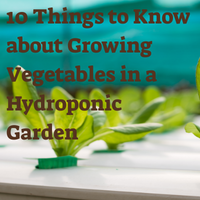Hydroponics is the answer to all the problems regarding soil, space and climate.
Normally, any plant will not survive without soil, and occupy too much space.
But with the help of hydroponic gardens and growth systems, farmers can get rid of all that constraints and save time, money, space and labor.

What Is Hydroponics?
As we have mentioned above, hydroponic is the alternative to the traditional farming practices.Typically, plants get their nutrients from a combination of soil, sunlight and other elements.
Hydroponics, on the other hands, utilizes a water based nutrients system designed to provide multiple plants the necessary sustenance without human labor and too much space.
The medium for growth is not soil, and the climate is controlled carefully.
In short, the advantages to the hydroponics include saving time, space, human labor, independency from natural climate etc.
But before you roll up your sleeves and start your own hydroponic garden to grow vegetables in, here is a list of 10 things that you need to understand.
1. Types of Hydroponic Systems:
There are different types of hydroponic systems that differentiate from each other based on how the nutrients reach the plants.
Deep water culture, wick system, drip systems, and nutrient film techniques are based on air pump systems, whereas ebb and flow and aeroponics also utilize timers to provide nutrients to the plants.All of the systems are a bit different from each other, for example, in ebb and flow method, the nutrients are pulled to the growth tray from the reservoir through a pump which is set by timer.
All the nutrients are drained to the reservoir after each plant has received some.
This is much different than the other systems, say deep water culture, where the potted plants are hanged by net in such a way that their roots are constantly submerged in the nutrient solution.
2. Growing Medium for Vegetables:
Obviously normal soil as a growing medium is not an option anymore.
Instead, other mediums are considered that can not only provide required nutrients to the plants, but also has the ability to transmit moisture and oxygen.
These mediums include Rockwool, Hydrocorn, perlite, vermiculite, growstones, expanded clay pellets, coconut coir and different grades of sands.
To be a good medium, the material has to possess following qualities:
- pH neutral
- Should hold moisture well
- Should hold oxygen well
- Environment friendly
3. Nutrients and Fertilizers for Hydroponic Plants:
All the plants need nutrients to grow and prosper.
These nutrients are divided into two categories; micronutrients and macronutrients.
Out of these two, the latter is needed in large quantities by plants while the former is enough in small quantities.There are macronutrients that plants require; hydrogen, carbon, oxygen, nitrogen, phosphorus, and potassium.
The first three are easily acquired from the air and water, but the latter three, also known as NPK, is given to the hydroponic plants through fertilizers.
In fact, NPK fertilizer mix is the best choice in this area.
Other two combinations are Calcium Nitrate and Magnesium Sulfate or Epsom salt.
The hydroponic plant is given a mixture of these three fertilizers to acquire all the nutrient it needs.
To summarize, hydroponic plants are also fertilized.
The nutrient solution comes in both liquid and powder form. They are very easy to use and concentrated.
4. Controlling the Climate:

One of the best qualities of hydroponics is that you can control the climate of the hydroponic garden yourself.
In other words, it is not dependent on the natural climate.
All plants need light, nutrients and water to grow and sustain them.
In a hydroponic garden, you have to set up a light system with the help of grow light to provide the plants necessary light.
Not only that, you also need to control and maintain the temperature and ventilation to the desired level to sustain the required climate.
5. Having Control of pH:
As you might know, pH refers to the acidity or alkalinity of a material.
Normally, hydroponic plants grow in a pH of 5.8 to 6.8, although 6.3 is best.
Controlling the pH of the growing medium is necessary, because that way you can ensure that the plants will absorb the maximum nutrients that they can.
To do that, you need to run pH test on the growing medium regularly, and use some specific fertilizer, organic matter, or a buffer solution to the reservoir.
6. No Limitations:
As we have mentioned above, in traditional systems, you need considerable amount of space for large yield.
Not only that, you have to be mindful of natural climate, temperature, season and place to grow a specific type of fruit or vegetable.
But in a hydroponic garden, you are the one in control, so you are not held back by these limitations.
You can make a hydroponic greenhouse or garden anywhere you want, and can grow the desired plant without needing too much space, human effort and seasons effects.
7. No Use of Pesticides:
In traditional farming and gardening, the owners have to utilize a mixture of herbicides and pesticides to get rid of any pests or diseases.
The downside of this is that the plants contain the traces of those harmful agents.
But as the soil is no longer used, the use of these harmful chemicals can be avoided and the yield produced would be fresh and completely safe.
8. No Weeds or Diseases:
One of the biggest advantage that you have in hydroponics is that you won’t have to tackle those annoying weeds that usually crop up regularly in traditional farming and gardens.
That’s not the only thing you can avoid.
It is rare if a disease attacks the plants, because most of the time the diseases or bacteria’s are born and bred in soil.
As soil is not the growing medium, you don’t have to worry about that anymore.
9. Hydroponic Vegetables:
The best vegetables to grow out in a hydroponic garden are strawberries, lettuce, tomatoes, basil, spinach, spring onion, coriander, peppers, cucumber, and blue berries.
Out of all of them, hydroponic tomatoes are the best, as you get the more yield, at least 3 to 10 times more than the traditional way, and the growth rate also increases dramatically from 30 to 50 percent.
Growing hydroponic vegetables save you a considerable amount of money.
As you are the one controlling the atmosphere by setting temperature and lights, you can grow vegetables all year round in any season.
10. Setting Up a Hydroponic System:
We have already discussed the different types of hydroponic systems.
Although all the systems are different, some basic components are still same.
First of all, you have to build a water reservoir, and then set up a growing tray.
You will also need to add additional components like pump and timer or other elements to build it.
Choose a growing medium carefully, and make a decision about what types of plants you want to grow so that you can fulfill the required conditions.
Don’t forget to add some growth lights strategically throughout the place to distribute the maximum amount of light equally over the wholes space.

